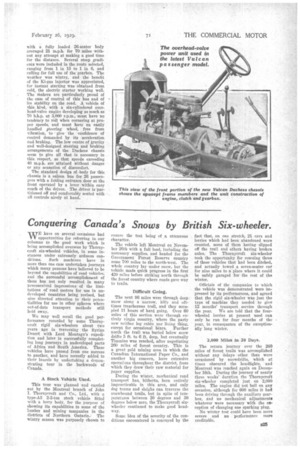Conquering Canada's Snows by British Six-wheeler.
Page 51

If you've noticed an error in this article please click here to report it so we can fix it.
WE have on several occasions had opportunities for referring in our columns to the good work which is being accomplished overseas by Thornycroft six-wheeled vehicles, in some instances under extremely arduous conditions. Such maehines have in more than one ease undertaken journeys which many persons have believed to be beyond the capabilities of road vehicles, and the successful accomplishment of them has not only resulted in many preconceived impressions of the limitations of road motors for use in undeveloped countries being revised, but also directed attention to their potentialities for use in other spheres where oat-of-date transport methods still
hold sway. .
We may well recall the good performance recorded by some Thornycroft rigid six-wheelers about two years ago in traversing the Syrian Desert with Lord Montagu's expedition and later in successfully completing long journeys in undeveloped parts of Africa and South America. These vehicles have passed from one success to another, and have recently added to their laurels by undertaking a demonstrating tour in the backwoods of Canada.
A Stock Vehicle Used.
This tour was planned and carried out by the Montreal branch of John I. Thornycroft and Co., Ltd.. with a type-A3 2-3-ton stock vehicle fitted with a lorry body, for the purpose of showing its capabilities to some of the lumber and mining companies in the districts of Northern Ontario.: The wintry season was purposely chosen to ensure the test being of a strenuous character.
The vehicle left Montreal on November 26th with a full load, including the necessary supplies, and headed for the Government Forest Reserve country some 700 miles to the north-west. The whole country lay -Under snows but the vehicle made quick progress in the first 420 miles before striking north through the forest country where roads gave way to trails.
Difficult Going.
The next 96 miles were through deep snow along a narrow, hilly and ofttimes treacherous trail, and they occupied 11 hours of hard going. Over 60 miles of this section were through entirely virgin country, where the party saw neither log cabin nor living thing, except for occasional bears. Further north the trail was buried below snow drifts ii ft. to 6 ft. deep, but eventually Timmins was reached, after negotiating 260 miles of forest country. This is a great gold mining area in which the Canadian International Paper Co., and another big concern, have extensive operations throughout the district, from which they draw their raw material for paper supplies.
During the winter, mechanical road transport has, hitherto, been entirely impracticable in this area, and only dog teams and sleighs can traverse the snowbound trails, but in spite of temperatures between 20 degrees and 30 degrees below zero, the Thornycroft sixwheeler continued to make good headway.
Some idea of the severity of the conditions encountered is conveyed by the fact that, on one stretch, 21 cars and lorries which had been abandoned were counted, some of them having slipped off the trail and others having broken axles. The Thornyeroft six-wheeler took the opportunity for reselling three of these vehicles that had been ditched, and actually towed a seven-seater car for nine miles to a place where it could be safely garaged for the rest of the winter.
Officials of the companies to svhich the vehicle was demonstrated were impressed by its performances, and agreed that the rigid six-wheeler was just the type of machine they needed to give 12 months' transport service through the year. We are told that the fourwheeled lorries at present used can only be run for four months of the year, in consequence of the exceptionally long winter.
2,000 Miles in 20 Days.
The return journey over the 260 miles of forest trails was accomplished without any delays other than were occasioned by snowdrifts, which at times obscured the headlights, and Montreal was reached again on December 16th. During the journey of nearly three weeks' duration the Thornycroft six-wheeler completed just on 2,000 miles. The engine did not boil on any occasion, although for 600 miles it had been driving through the auxiliary gearbox, and no mechanical adjustments whatever were necessary with the exception of changing one sparking plug.
No winter test could have been more severe and no performance more creditable.




















































































































